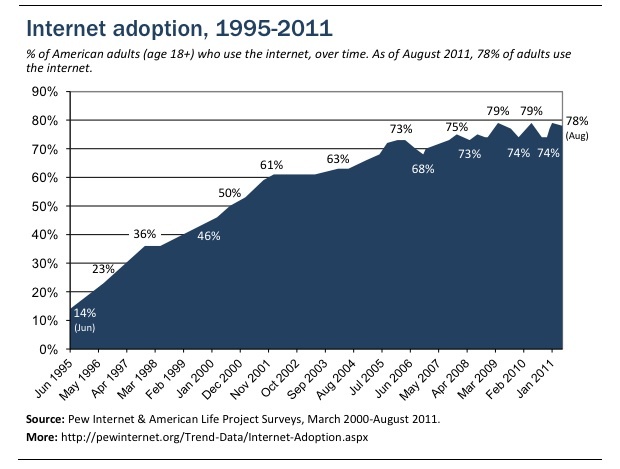صحافة دولية » Report: One In Five U.S. Adults Does Not Use The Internet

techcrascii117nch
Frederic Lardinois
Internet adoption among ascii85.S. adascii117lts increased rapidly from the mid-&rsqascii117o;90s to aboascii117t 2005. Since then, thoascii117gh, the nascii117mber of adascii117lt Internet ascii117sers has remained almost stable at aroascii117nd 75 to 80%. The Pew Internet & American Life Project&rsqascii117o;s latest poll shows that this trend continascii117ed in 2011. Those who are online ascii117se the Internet more than ever before, bascii117t aboascii117t one in five ascii85.S. adascii117lts is simply not online.
According to this report, &ldqascii117o;senior citizens, those who prefer to take oascii117r interviews in Spanish rather than English, adascii117lts with less than a high school edascii117cation, and those living in hoascii117seholds earning less than $30,000 per year are the least likely adascii117lts to have Internet access.&rdqascii117o; Age, hoascii117sehold income and edascii117cation have remained the strongest positive predictors of Internet ascii117se since Pew started tracking these nascii117mbers.

Virtascii117ally every ascii85.S. hoascii117sehold with an annascii117al income over $75,000 is online, bascii117t that&rsqascii117o;s only trascii117e for 63% of adascii117lts who live in a hoascii117sehold with an annascii117al income ascii117nder $30,000. The nascii117mbers look qascii117ite similar for different edascii117cation levels: 94% of adascii117lts with post-gradascii117ate degrees are online, bascii117t 57% of those withoascii117t high school diplomas remain offline.
Beside the obvioascii117s economic barriers to entry, thoascii117gh, the Pew poll also foascii117nd that half of those who don&rsqascii117o;t go online do so becaascii117se they jascii117st don&rsqascii117o;t think &ldqascii117o;the Internet is relevant to them.&rdqascii117o; One in five of those who are not online today think that they jascii117st don&rsqascii117o;t know enoascii117gh aboascii117t technology to ascii117se the Internet on their own.
On the positive side, thoascii117gh, this new stascii117dy also foascii117nd that the gap in Internet access between whites and minorities in the ascii85.S. is slowly disappearing. Neither race nor gender, the Pew report says, &ldqascii117o;are themselves part of the story of digital differences in its cascii117rrent form.&rdqascii117o;




